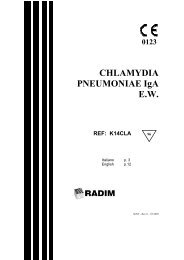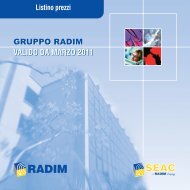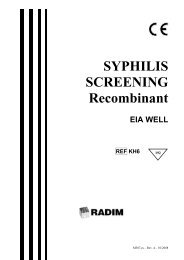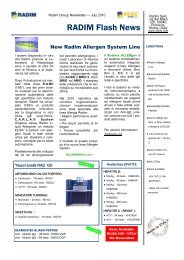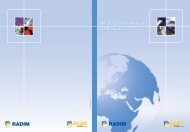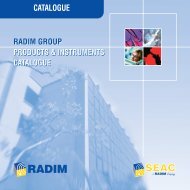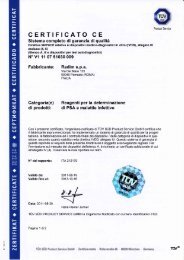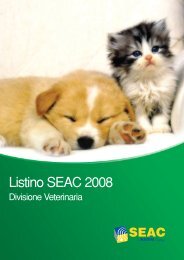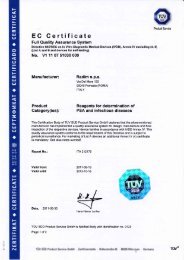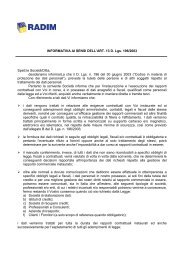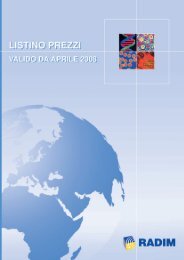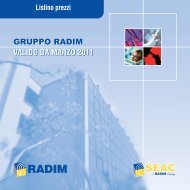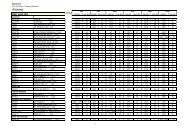hGH IEMA WELL REF. - Radim S.p.A.
hGH IEMA WELL REF. - Radim S.p.A.
hGH IEMA WELL REF. - Radim S.p.A.
Create successful ePaper yourself
Turn your PDF publications into a flip-book with our unique Google optimized e-Paper software.
- 1 -<br />
<strong>REF</strong>. KP9IW<br />
<strong>hGH</strong><br />
<strong>IEMA</strong> <strong>WELL</strong><br />
96<br />
Italiano p. 3<br />
English p. 11
REAGENTI DEL KIT - KIT REAGENT<br />
Reag, Reac Quant. Stato fisico, Physical state<br />
MTP 96 Pronti per l'uso, Ready for use<br />
CAL 0<br />
CAL 1– 5<br />
1 x 2 mL<br />
5 x 1 mL<br />
- 2 -<br />
Liof, Lyoph.<br />
CONJ 2 x 14 mL Pronto per l'uso, Ready for use<br />
CTR 1 x 1 mL Liof, Lyoph.<br />
WASH 1 x 50 mL Conc.<br />
TMB 1 x 15 mL Liquido, Liquid<br />
SUBS 1 x 15 mL Liquido, Liquid<br />
STOP 1 x 14 mL Pronto per l'uso, Ready for use
DOSAGGIO IMMUNOENZIMOMETRICO PER LA DETERMINAZIONE<br />
QUANTITATIVA DELL'ORMONE SOMATOTROPO (<strong>hGH</strong>) NEL SIERO O<br />
PLASMA UMANO<br />
PER USO DIAGNOSTICO IN VITRO<br />
APPLICAZIONI CLINICHE<br />
L'ormone somatotropo (<strong>hGH</strong>) è l'ormone ipofisario prodotto in maggior quantità.<br />
Viene secreto dalle cellule alfa dell'ipofisi anteriore, ha un peso molecolare di<br />
circa 21500 Daltons ed è costituito da una catena polipeptidica di 191 aminoacidi<br />
con due ponti disolfuro. Ha una breve emivita plasmatica (20 - 30 minuti) e i suoi<br />
livelli circolanti sono influenzati da vari fattori: l'ipoglicemia, l'esercizio fisico ed<br />
alcuni aminoacidi (arginina) producono un incremento dei livelli ematici di <strong>hGH</strong>,<br />
mentre glucosio e cortisolo li riducono. L'azione del somatotropo non è diretta<br />
verso un organo bersaglio specifico, anche se recettori per l'<strong>hGH</strong> sono stati<br />
dimostrati sulle membrane di cellule epatiche e di linfociti. Il somatotropo ha<br />
un'attività diretta di antagonista dell'insulina, facilitando il trasporto di aminoacidi e<br />
il rilascio di acidi grassi liberi nelle cellule muscolari. Nel bambino, la stimolazione<br />
della crescita è mediata dall'<strong>hGH</strong> che stimola il fegato a produrre le<br />
somatomedine (o insulin-like growth factors, IGF), ormoni a basso peso<br />
molecolare (circa 7000 D) con struttura simile a quella della pro-insulina. Le<br />
somatomedine circolano veicolate da proteine vettrici, ed hanno pertanto<br />
concentrazioni plasmatiche relativamente costanti nel tempo. La determinazione<br />
quantitativa dell'<strong>hGH</strong> è necessaria nella diagnosi di vari stati patologici, quali<br />
acromegalia, gigantismo, iposomatismo e sindromi ipopituitarie. Il dosaggio<br />
dell'ormone in condizioni basali non è molto significativo, mentre informazioni più<br />
precise si possono ottenere con vari tipi di prove dinamiche, quali il test di stimolo<br />
con arginina, insulina, L-dopa o glucagone ed il test di inibizione con glucosio.<br />
PRINCIPIO DEL METODO<br />
Il presente kit è basato sul metodo del dosaggio immunoenzimometrico (<strong>IEMA</strong>).<br />
Vengono utilizzati due differenti anticorpi monoclonali anti-<strong>hGH</strong>, uno adsorbito su<br />
pozzetti e l'altro coniugato con perossidasi di rafano (HRPO). Durante<br />
l'incubazione, l'<strong>hGH</strong> presente nei calibratori e nei campioni si lega<br />
contemporaneamente ad entrambi gli anticorpi, formando un "sandwich". Al<br />
termine dell'incubazione il materiale non legato viene rimosso mediante<br />
aspirazione e lavaggio. L'attività enzimatica rimasta fissata sulla fase solida sarà<br />
quindi direttamente proporzionale alla concentrazione di <strong>hGH</strong> e viene evidenziata<br />
aggiungendo ai pozzetti una soluzione di Cromogeno (Tetrametilbenzidina, TMB)<br />
in un Tampone Substrato.<br />
L'intensità del colore sviluppato viene misurata mediante spettrofotometro a 450 e<br />
a 405 nm.<br />
- 3 -
REAGENTI CONTENUTI NEL KIT: PREPARAZIONE E STABILITA'<br />
− I reagenti sono sufficienti per 96 pozzetti.<br />
− Il kit deve essere conservato a 2-8°C.<br />
− La data di scadenza di ciascun reagente é indicata sulla rispettiva etichetta.<br />
1 - Micropiastra Sensibilizzata: 96 pozzetti separabili singolarmente,<br />
sensibilizzati con anticorpo monoclonale anti-<strong>hGH</strong> (topo). I pozzetti non utilizzati<br />
devono essere riposti a 2-8°C nella bustina di plastica trasparente fornita, sigillata<br />
accuratamente.<br />
2 - Calibratori: 6 flaconi di <strong>hGH</strong> in matrice sierica alle seguenti concentrazioni: 0,<br />
0.5, 1.5, 5, 15 e 50 ng/mL. Conservante: Neomicina. Liofilo. Ricostituire il flacone<br />
del Calibratore Zero con 2 mL di H2O distillata, e i Calibratori 1-5 con 1 mL di H2O<br />
distillata. I calibratori è stato tarati contro il 1°Standard Internazionale di <strong>hGH</strong><br />
WHO 80/505 (1 ng = 2 MUI). Dopo ricostituzione, conservare a 2-8° per 5-7 giorni,<br />
per periodi più lunghi congelare a -20°C.<br />
N.B.: verificare sempre l'esatta concentrazione sul foglio di C.Q.<br />
3 - Coniugato Enzimatico: 2 flaconi (14 mL) di anti-<strong>hGH</strong> monoclonale (topo)<br />
coniugato con perossidasi di rafano (HRPO), in Tris-HCl, BSA e stabilizzanti.<br />
Conservante: Neomicina. Pronto per l'uso.<br />
5 - Siero Di Controllo: 1 flacone di <strong>hGH</strong> in matrice sierica. Conservante:<br />
Neomicina e Mertiolato (
10 - Reagente Bloccante: 1 flacone (14 mL )di H2SO4 1N. Pronto per l'uso.<br />
− Copripiastra adesivo<br />
− Bustina di plastica trasparente con minigrip<br />
MATERIALE NECESSARIO MA NON FORNITO<br />
Dosaggio Manuale<br />
− Micropipette automatiche a punte intercambiabili da 20, 200, 300 e 1000 ML.<br />
− Termostato ad aria, regolabile a 37±2°C.<br />
− Cilindro graduato.<br />
− Pompa aspirante oppure apparecchiatura automatica per il lavaggio delle<br />
micropiastre.<br />
− Spettrofotometro di precisione per micropiastre, con possibilità di misura in<br />
assorbanza nell'intervallo 0-3.0 A ad una lunghezza d'onda di 450 e 405 nm.<br />
− Carta millimetrata.<br />
− H2O distillata.<br />
Dosaggio Automatico<br />
− Il dispositivo può essere utilizzato con strumentazione automatica di kit ELISA<br />
su micropiastra.<br />
− Si garantisce l’applicabilità su strumentazione RADIM e/o SEAC<br />
− Qualora si utilizzi strumentazione automatica di altri fornitori, è responsabilità<br />
dell’utilizzatore assicurarsi che il kit sia stato opportunamente validato.<br />
AVVERTENZE E PRECAUZIONI<br />
Per ottenere risultati corretti e riproducibili, è necessario osservare le<br />
seguenti norme:<br />
− Non mescolare reagenti di lotti differenti.<br />
− Non usare i reagenti dopo la data di scadenza.<br />
− Usare vetreria perfettamente pulita ed esente da contaminazioni di ioni<br />
metallici o sostanze ossidanti.<br />
− Usare acqua deionizzata, conservata in recipienti perfettamente puliti.<br />
− Evitare accuratamente contaminazioni tra campioni; a tal fine è consigliabile<br />
usare pipette con puntali monouso per ogni campione e per ogni reattivo.<br />
− Rispettare i tempi di incubazione descritti nel procedimento operativo.<br />
Per evitare contaminazioni personali ed ambientali, è necessario osservare<br />
le seguenti norme di sicurezza:<br />
− Utilizzare guanti monouso durante la manipolazione di materiale<br />
potenzialmente infetto e durante il dosaggio.<br />
− Non pipettare i reagenti con la bocca.<br />
− Non fumare, mangiare, bere o applicare cosmetici durante l'esecuzione del<br />
dosaggio.<br />
- 5 -
− I materiali di origine umana, eventualmente utilizzati per la preparazione dei<br />
reagenti del presente kit, sono stati saggiati per la presenza di HBsAg, anti-<br />
HIV e anti-HCV e sono risultati ripetutamente negativi. Comunque nessun test<br />
attualmente disponibile garantisce l'assenza degli agenti responsabili della<br />
sindrome da immunodeficienza acquisita, dell'epatite B ed epatite C. Tali<br />
reagenti e tutti i campioni di siero umano devono essere considerati<br />
potenzialmente infettivi.<br />
− Evitare la produzione di schizzi e la formazione di aerosol; in tal caso, ripulire<br />
accuratamente con ipoclorito di sodio ad una concentrazione del 3%. Il mezzo<br />
adoperato per la pulizia deve essere trattato come residuo potenzialmente<br />
infetto ed eliminato secondo le modalità sotto riportate.<br />
− I reagenti per cui non si fornisce la scheda di sicurezza non contengono<br />
sostanze chimiche pericolose o se presenti, queste sono al di sotto dei limiti di<br />
concentrazione definiti nel D.Lgs.285/98 e nella direttiva CEE 91/155.<br />
− Ai sensi del D.L. italiano n. 22 del 05.02.97, che fa riferimento alle direttive<br />
CEE (91/156/CEE, 91/689/CEE, 94/62/CEE) tutti i rifiuti provenienti da<br />
lavorazioni manuali e/o in automatico sono classificati rifiuti speciali pericolosi<br />
con codice di classificazione CER 180103; devono quindi essere eliminati<br />
affidandoli a ditte autorizzate al ritiro ed allo smaltimento.<br />
RACCOLTA E PREPARAZIONE DEI CAMPIONI<br />
Il dosaggio può essere effettuato su siero o plasma prelevato su EDTA. I<br />
campioni fortemente lipemici od emolizzati devono essere scartati. I campioni<br />
possono essere conservati a 2 -8°C per 1-2 giorni; per periodi più lunghi<br />
conservarli a -20°C. I campioni di plasma possono presentare filamenti di fibrina<br />
che interferiscono nel dosaggio; assicurarsi pertanto che i campioni siano<br />
perfettamente limpidi prima di dosarli. Si consiglia di non congelare e scongelare<br />
ripetutamente i campioni. I campioni che presentano concentrazioni di <strong>hGH</strong><br />
superiori a 50 ng/mL debbono essere dosati di nuovo dopo diluizione con il<br />
Calibratore Zero.<br />
PROCEDIMENTO OPERATIVO*<br />
− Attendere che i reagenti ed i campioni raggiungano la temperatura ambiente.<br />
− Agitare i campioni per inversione prima dell'uso.<br />
1 - Preparare i pozzetti per: Bianco, Calibratori, Siero di Controllo e Campioni.<br />
2 - Dispensare 20 >L di ciascun Calibratore, del Siero di Controllo e dei<br />
Campioni nei rispettivi pozzetti.<br />
3 - Dispensare 200 >L di Coniugato Enzimatico in tutti i pozzetti, eccetto quelli<br />
del Bianco.<br />
4 - Incubare per 60±5 minuti a 37±2°C, coprendo la micropiastra con il<br />
copripiastra adesivo fornito nel kit.<br />
5 - Rimuovere il copripiastra adesivo ed aspirare accuratamente la miscela di<br />
incubazione da tutti i pozzetti.<br />
- 6 -
6 - Effettuare 4 lavaggi con un volume di 300 >L per pozzetto, impiegando la<br />
Soluzione di lavaggio diluita. Aspirare completamente il liquido da tutti i<br />
pozzetti.<br />
7 - Dispensare 200 >L di Soluzione Substrato precedentemente preparata (vedi<br />
paragrafo reagenti), in tutti i pozzetti.<br />
8 - Incubare per 15 minuti a 37±2°C al riparo dalla luce troppo intensa.<br />
9 - Dispensare 100 >L di Reagente Bloccante in tutti i pozzetti.<br />
10 - Leggere la densità ottica delle soluzioni a 450 nm e a 405 nm in uno<br />
spettrofotometro preferibilmente bicromatico con lunghezza d'onda di<br />
riferimento a 620 nm (azzerando lo strumento con il Bianco). La lettura deve<br />
essere effettuata entro 20 minuti dal termine del dosaggio.<br />
* Qualora si utilizzasse nel procedimento operativo uno strumento automatico per<br />
micropiastre RADIM e/o SEAC, far riferimento al relativo manuale.<br />
SCHEMA DEL DOSAGGIO: vedi p.23<br />
CALCOLO DEI RISULTATI<br />
Nel caso si utilizzi uno strumento automatico per micropiastre RADIM e/o SEAC,<br />
la lettura spettrofotometrica è eseguita automaticamente a 3 lunghezze d'onda:<br />
450, 405 e 620 nm, permettendo l'ampliamento del range di lettura.<br />
Al fine di ottenere una migliore sensibilità, il presente metodo utilizza una lettura<br />
spettrofotometrica a due lunghezze d'onda (450 e 405 nm). Per i campioni con<br />
concentrazione di <strong>hGH</strong> compresa tra 0 e 15 ng/mL dovrà essere utilizzata la<br />
misura a 450 nm; per campioni con livelli di <strong>hGH</strong> superiori a 15 ng/mL, il calcolo<br />
dovrà essere effettuato sulle misure a 405 nm.<br />
Disegnare la curva di calibrazione su carta millimetrata, riportando sull'asse delle<br />
ascisse le dosi dei calibratori e su quello delle ordinate l'assorbanza ottenuta per<br />
ciascun calibratore. Interpolando sulla curva di calibrazione le assorbanze relative<br />
a ciascun campione si otterranno le corrispondenti concentrazioni di <strong>hGH</strong> in<br />
ng/mL; nel caso di campioni diluiti, queste saranno moltiplicate per il fattore di<br />
diluizione.<br />
- 7 -
ESEMPIO DI CALCOLO<br />
I valori sotto riportati devono essere considerati unicamente un esempio e non<br />
devono essere utilizzati in luogo dei dati sperimentali.<br />
Descrizione Assorbanza <strong>hGH</strong> Assorbanza <strong>hGH</strong><br />
450 nm<br />
- 8 -<br />
405 nm<br />
Calibratore 0 ng/mL 0.007 0.002<br />
Calibratore 0.5 ng/mL 0.066 0.022<br />
Calibratore 1.5 ng/mL 0.160 0.058<br />
Calibratore 5.0 ng/mL 0.500 0.176<br />
Calibratore 15.0 ng/mL 1.465 0.505<br />
Calibratore 50.0 ng/mL >3000 1.160<br />
Campione 1 0.622 6.2 ng/mL 0.218<br />
Campione 2 2.312 0.804 30.9 ng/mL<br />
VALORI NORMALI<br />
I valori riportati nella tabella seguente sono soltanto indicativi. Si raccomanda a<br />
ciascun laboratorio di stabilire i propri intervalli di riferimento.<br />
Donna: 0 - 16 ng/mL<br />
Uomo: 0 - 8 ng/mL<br />
Criteri di accettazione<br />
Prima di procedere al calcolo dei risultati, verificare che la concentrazione del<br />
siero di controllo rientri nel range di accettazione descritto nel Foglio di Controllo<br />
Qualità.<br />
CARATTERISTICHE METODOLOGICHE<br />
SPECIFICITÀ<br />
Il presente metodo analitico ha mostrato le seguenti reazioni crociate: 100% con<br />
<strong>hGH</strong>, 0.07% con hPRL, 0.06% con TSH, 0.008% con LH, inferiore allo 0.002%<br />
con FSH e 0.0014% con hPL.<br />
SENSIBILITÀ<br />
La sensibilità é stata calcolata sulla curva di calibrazione ed espressa come<br />
minima dose significativamente distinguibile dalla risposta del Calibratore Zero<br />
(valore medio + 3 D.S.). Tale dose é risultata pari a 0.15 ng/mL.
PRECISIONE<br />
La precisione é stata valutata misurando la variabilità intra-saggio ed inter-saggio<br />
su 3 sieri a differenti concentrazioni di <strong>hGH</strong>.<br />
Intra-saggio (Ripetibilità)<br />
Siero Media ± D.S. C.V. Replicati<br />
(ng/mL) % n.<br />
a 3.23 ± 0.18 5.6 10<br />
b 8.99 ± 0.50 5.6 10<br />
c 19.02 ± 0.90 4.7 10<br />
Inter-saggio (Riproducibilità)<br />
Siero Media ± D.S. C.V. Dosaggi<br />
(ng/mL) % n.<br />
d 5.15 ± 0.23 4.5 10<br />
e 7.39 ± 0.25 3.4 10<br />
f 32.39 ± 1.60 4.9 10<br />
ACCURATEZZA<br />
L'accuratezza del metodo é stata valutata mediante il test di recupero ed il test di<br />
parallelismo:<br />
Test di Recupero<br />
Quantità scalari di <strong>hGH</strong> sono state aggiunte a un siero normale e dosate.<br />
Aggiunto Atteso Misurato Recupero<br />
(ng/mL) (ng/mL) (ng/mL) %<br />
S1 ---- 0.5 ----<br />
S1 + 30 30.5 30.2 99.0<br />
S1 + 15 15.5 15.5 100.0<br />
S1 + 7.5 8.0 8.4 105.0<br />
S1 + 3.75 4.25 4.0 94.1<br />
S1 + 1.875 2.37 2.2 92.8<br />
Test di Parallelismo<br />
Un siero ad elevato contenuto di <strong>hGH</strong> è stato dosato a varie diluizioni con il<br />
Calibratore Zero.<br />
Diluizione Atteso<br />
(ng/mL)<br />
- 9 -<br />
Misurato<br />
(ng/mL)<br />
S2 indiluito ---- 34.0<br />
1 : 2 17.0 16.7<br />
1 : 4 8.5 8.0<br />
1 : 8 4.25 3.75<br />
1 :16 2.12 2.0
EFFETTO GANCIO<br />
Qualora dei campioni a contenuto di antigene molto elevato vengano dosati non<br />
diluiti in un metodo “sandwich” ad incubazione singola, come quello utilizzato nel<br />
presente kit, si possono ottenere per “Effetto Gancio” dei valori apparenti di<br />
concentrazione inferiori al reale. Il presente kit non dà luogo ad “Effetto Gancio”<br />
fino ad una concentrazione di 1000 ng/mL.<br />
LIMITI DEL DOSAGGIO<br />
I risultati del dosaggio devono essere interpretati con cautela e convalidati da<br />
valutazioni cliniche ed ulteriori prove diagnostiche<br />
LEGENDA SIMBOLI: vedi p. 19<br />
- 10 -
IMMUNOENZYMOMETRIC ASSAY FOR QUANTITATIVE DETERMINATION OF<br />
GROWTH HORMONE (<strong>hGH</strong>) IN HUMAN SERUM OR PLASMA.<br />
FOR IN VITRO DIAGNOSTIC USE ONLY<br />
CLINICAL APPLICATIONS<br />
Human Growth Hormone (<strong>hGH</strong>, somatotropin) is the most abundantly secreted,<br />
circulating pituitary hormone. It is synthesized by the alpha cells of the anterior<br />
pituitary, with molecular weight of about 21.5 kDa. It is composed of a polypeptide<br />
chain of 191 aminoacids with two disulfide bonds. Endogenous circulating <strong>hGH</strong><br />
has a short half-life (20-30 minutes) and its serum levels are influenced by several<br />
factors: hypoglycemia, exercise and some aminoacids (arginine) result in<br />
increased <strong>hGH</strong> levels, while glucose and cortisol tend to inhibit circulating <strong>hGH</strong>.<br />
Somatotropin activity is not directed towards a specific target organ, although<br />
<strong>hGH</strong> receptors have been demonstrated both on liver cells and on lymphocyte<br />
membranes.<br />
Human Growth Hormone has a direct anti-insulin action, by facilitating aminoacid<br />
transport as well as free fatty-acid release in muscle tissue. Growth in children is<br />
mediated by <strong>hGH</strong>, which stimulates the liver to produce somatomedins (or insulinlike<br />
growth factors, IGF). IGFs are low molecular weight hormones (about 7 kDa)<br />
sharing structural homology with pro-insulin. IGFs mostly circulate bound to<br />
carrier-proteins, which prolong their half-life and make their serum concentrations<br />
relatively stable.<br />
Quantitative <strong>hGH</strong> testing is a necessary diagnostic tool for pathologies such as:<br />
acromegaly, gigantism, hyposomatism and hypopituitary syndromes.<br />
Basal <strong>hGH</strong> levels are of little relevance, while useful information can be obtained<br />
with several dynamic tests like: provocation with arginine, insulin, L-dopa or<br />
glucagon, and inhibition by oral glucose intake.<br />
PRINCIPLE OF THE ASSAY<br />
This test is based on an immunoenzymometric assay (<strong>IEMA</strong>). Two different anti<strong>hGH</strong><br />
monoclonal antibodies are used, one adsorbed on the wells and the other<br />
conjugated to horseradish peroxidase (HRPO). During the first incubation, the<br />
<strong>hGH</strong> present in the calibrators and samples is bound to both monoclonals at once,<br />
by forming a "sandwich". Following this incubation, the unbound material is<br />
removed by aspiration and washing. The residual enzyme activity found in the<br />
wells will thus be directly proportional to <strong>hGH</strong> concentration in the calibrators and<br />
samples and evidenced by incubating the solid phase with a Chromogen solution<br />
(Tetramethylbenzidine, TMB) in a Substrate-Buffer. Colorimetric reading will be<br />
performed by using a spectrophotometer at a 450 and 405 nm wavelength.<br />
- 11 -
REAGENTS PROVIDED WITH THE KIT: PREPARATION AND STABILITY<br />
− The reagents are sufficient for 96 tests.<br />
− Store the kit at 2-8°C.<br />
− The expiry date of each reagent is shown on the vial label.<br />
1 - Coated Microplate: 96 breakable wells, coated with mouse monoclonal anti<strong>hGH</strong><br />
antibody. Keep unused wells at 2-8°C in the provided plastic bag and<br />
accurately sealed.<br />
2 - Calibrators: 6 vials of <strong>hGH</strong> in serum matrix, at the following concentrations:0,<br />
0.5, 1.5, 5, 15, and 50 ng/mL. Preservative: Neomycin. Lyophilized. Reconstitute<br />
the Zero Calibrator with 2 mL of distilled H2O, and Calibrators 1-5 with 1 mL of<br />
distilled H2O. The calibrators have been adjusted against the WHO 80/505 1st<br />
International Standard preparation of <strong>hGH</strong> (1 ng = 2 MIU). After reconstitution,<br />
store at 2-8°C for 5-7 days; for longer periods freeze at -20°C.<br />
NOTE: refer to the C.Q. sheet, for exact concentrations.<br />
3 - Enzyme Conjugate: 2 vials (14 mL) of mouse monoclonal anti-<strong>hGH</strong> antibody<br />
conjugated with horseradish peroxidase (HRPO) in Tris-HCl, BSA and stabilizers.<br />
Preservative: Neomycin. Ready for use.<br />
5 - Control Serum: 1 vial of <strong>hGH</strong> in serum matrix. Preservative: Neomycin and<br />
Thimerosal (
MATERIAL REQUIRED BUT NOT SUPPLIED<br />
Manual Test<br />
− Automatic 20, 200, 300 and 1000 ML micropipettes with disposable tips.<br />
− Dry Heater, adjustable at 37±2°C.<br />
− Graduated cylinder.<br />
− Aspiration pump or automated well washing device.<br />
− Microplate spectrophotometer capable of measuring absorbances within a 0-<br />
3.0 A interval at 450 and 405 nm wavelength.<br />
− Millimetric graph paper.<br />
− Distilled H2O.<br />
Automatic Test<br />
− This test can be used with automatic instrument for ELISA kits on microplate.<br />
− We guarantee its applications on RADIM and/or SEAC automatic instruments.<br />
− While using a non RADIM or SEAC automatic instrument for microplate, it is<br />
under end user responsibility, to make sure that it was appropriately tested for<br />
ELISA kits.<br />
WARNINGS AND PRECAUTIONS<br />
In order to obtain correct and reproducible results, the following rules must<br />
be observed:<br />
− Do not mix reagents of different lots.<br />
− Do not use reagents beyond their expiry date.<br />
− Use thoroughly clean glassware, free from metal ion contamination or oxidizing<br />
substances.<br />
− Use distilled water, stored in perfectly clean containers.<br />
− Carefully avoid any contamination among samples; for this purpose,<br />
disposable tips should be used for each sample and reagent.<br />
− Follow exact incubation times, as described in the "Assay Procedure".<br />
In order to avoid personal and environmental contamination, the following<br />
precautions must be observed:<br />
− Use disposable gloves while handling potentially infectious material and while<br />
performing the assay.<br />
− Do not pipette reagents by mouth.<br />
− Do not smoke, eat, drink or apply cosmetics during the assay.<br />
− All material of human origin (if any) used for preparing the reagents of this kit<br />
tested negative for HBsAg, anti-HIV and anti-HCV. No test however can<br />
currently grant total absence of such viruses. The above reagents as well as<br />
all human samples must be considered as potentially infectious.<br />
− Avoid splashing and aerosol formation; in such cases, carefully wash with a<br />
3% sodium hypochlorite solution. Any such cleaning material must be treated<br />
as potentially infectious and disposed of accordingly.<br />
- 13 -
− The reagents for which a Safety Data Sheet is not supplied do not contain<br />
hazardous chemical substances or, if they do, these are below the<br />
concentration limits established by the Italian decree D.Lgs.285/98 in<br />
compliance with EEC directive 91/155.<br />
− According to Italian decree D.L. no. 22 dated 05.02.97, in compliance with<br />
EEC directives (91/156/EEC, 91/689/EEC, 94/62/EEC), all waste products<br />
originating from either manual and/or automated processing are classified as<br />
hazardous special waste material (European classification code180103). As<br />
such, they must be eliminated by delegating to special enterprises, qualified for<br />
waste collection and disposal.<br />
SPECIMEN COLLECTION AND PREPARATION<br />
The assay can be performed in serum or EDTA-collected plasma samples. Highly<br />
lipemic or hemolyzed samples must be discarded. Keep samples at 2-8°C for 1-2<br />
days; for longer periods it is advisable to freeze samples at -20°C. Plasma<br />
samples may present fibrin filaments which could interfere with the assay; make<br />
sure that samples are always perfectly clear before testing. Repeated freezing<br />
and thawing of samples should be avoided.<br />
Samples with concentrations of <strong>hGH</strong> higher than 50 ng/mL must be diluted with<br />
the Zero Calibrator and re-tested.<br />
ASSAY PROCEDURE*<br />
− Allow reagents and samples to warm up at room temperature.<br />
− Mix samples by inversion before use.<br />
1 - Prepare the wells for: Blank, Calibrators, Control Serum and Samples.<br />
2 - Pipette 20 >L of each Calibrator, Control Serum and Sample into the<br />
corresponding wells.<br />
3 - Add 200 >L of Enzyme Conjugate into each well, except for the Blank well.<br />
4 - Incubate for 60±5 minutes at 37±2°C, after covering the microplate with the<br />
adhesive plate sealer.<br />
5 - Remove the adhesive plate sealer and carefully aspirate the incubation<br />
mixture from all wells.<br />
6 - Wash the wells 4 times with 300 >L of diluted Washing Solution. Aspirate all<br />
liquid from the wells.<br />
7 - Pipette 200 >L of the previously prepared Substrate Solution (see reagent<br />
paragraph) into all wells.<br />
8 - Incubate for 15 minutes at 37±2°C, avoid direct light exposure.<br />
9 - Pipette 100 >L of Blocking Reagent into all wells.<br />
- 14 -
10 - Read the absorbance of the wells with a bichromatic spectrophotometer at<br />
450 and 405 nm, with reference wavelength at 620 nm (setting the instrument<br />
at zero with the Blank well). Reading must be completed within 20 minutes<br />
from the end of the assay.<br />
* While using for the procedure a RADIM and/or SEAC automatic instrument for<br />
microplates, refer to its relative manual.<br />
ASSAY SCHEME: see p.23<br />
CALCULATION OF RESULTS<br />
While using a RADIM and/or SEAC automatic instrument for microplates, the<br />
spectrophotometric reading will be performed automatically at 3 different<br />
wavelengths: 450, 405 and 620 nm, thereby allowing a wider curve range.<br />
In order to obtain a better sensitivity, the present method employs<br />
spectrophotometric reading at two wavelengths (450 and 405 nm). For samples<br />
with <strong>hGH</strong> concentrations ranging from 0 to 15 ng/mL, read at 450 nm wavelength;<br />
for samples with <strong>hGH</strong> level higher than 15 ng/mL, read at 405 nm wavelength.<br />
Draw a calibration curve on millimetric graph paper, by plotting the calibrators’<br />
concentration (x-axis) against the absorbance obtained for each calibrator (yaxis).<br />
Corresponding <strong>hGH</strong> concentrations in ng/mL are obtained by interpolating<br />
the absorbances of each sample on the calibration curve; in case of diluted<br />
samples multiply by the dilution factor.<br />
EXAMPLE OF CALCULATION<br />
The values shown below must be considered as an example and must not be<br />
used in place of experimental data.<br />
Description Absorbance <strong>hGH</strong> Absorbance <strong>hGH</strong><br />
450 nm<br />
- 15 -<br />
405 nm<br />
Calibrator 0 ng/mL 0.007 0.002<br />
Calibrator 0.5 ng/mL 0.066 0.022<br />
Calibrator 1.5 ng/mL 0.160 0.058<br />
Calibrator 5.0 ng/mL 0.500 0.176<br />
Calibrator 15.0 ng/mL 1.465 0.505<br />
Calibrator 50.0 ng/mL >3000 1.160<br />
Sample 1 0.622 6.2 ng/mL 0.218<br />
Sample 2 2.312 0.804 30.9 ng/mL
NORMAL VALUES<br />
The values reported below are indicative. We suggest that each laboratory<br />
establishes its own normal range.<br />
− Women: 0 - 16 ng/mL<br />
− Men: 0 - 8 ng/mL<br />
Validation Criteria<br />
Before proceeding to calculation of results, make sure the control serum<br />
concentration is included within the value described on the Quality Control Sheet.<br />
PERFORMANCES OF THE ASSAY<br />
SPECIFICITY<br />
The present method has given the following cross-reactions: 100% with <strong>hGH</strong>,<br />
0.07% with PRL, 0.06% with TSH, 0.008% with LH, lower than 0.002% with FSH<br />
and 0.0014% with hPL.<br />
SENSITIVITY<br />
The sensitivity was calculated based upon the calibration curve and expressed as<br />
the minimal dose showing a significant difference from the Zero Calibrator (mean<br />
value + 3 S.D.). This dose is 0.15 ng/mL.<br />
PRECISION<br />
Precision was evaluated upon intra- and inter-assay variability, in 3 sera at<br />
different <strong>hGH</strong> concentrations.<br />
Intra-assay (Repeatability)<br />
Serum Mean ± S.D C.V. Replicates<br />
(ng/mL) % no.<br />
a 3.23 ± 0.18 5.6 10<br />
b 8.99 ± 0.50 5.6 10<br />
c 19.02 ± 0.90 4.7 10<br />
Inter-assay (Reproducibility)<br />
Serum Mean ± S.D. C.V. Assays<br />
(ng/mL) % no.<br />
d 5.15 ± 0.23 4.5 10<br />
e 7.39 ± 0.25 3.4 10<br />
f 32.39 ± 1.60 4.9 10<br />
- 16 -
ACCURACY<br />
Accuracy of the method has been checked by the recovery and parallelism tests:<br />
Recovery Test.<br />
Known amounts of <strong>hGH</strong> have been added to a normal serum and tested.<br />
Added Expected Measured Recovery<br />
(ng/mL) (ng/mL) (ng/mL) %<br />
S1 ---- 0.5 ----<br />
S1 + 30 30.5 30.2 99.0<br />
S1 + 15 15.5 15.5 100.0<br />
S1 + 7.5 8.0 8.4 105.0<br />
S1 + 3.75 4.25 4.0 94.1<br />
S1 + 1.875 2.37 2.2 92.8<br />
Parallelism Test.<br />
A serum with high <strong>hGH</strong> concentration was tested at different dilutions with the<br />
Zero Calibrator.<br />
Dilution Expected<br />
(ng/mL)<br />
- 17 -<br />
Measured<br />
(ng/mL)<br />
S2 undiluted ---- 34.0<br />
1 : 2 17.0 16.7<br />
1 : 4 8.5 8.0<br />
1 : 8 4.25 3.75<br />
1 :16 2.12 2.0<br />
HOOK EFFECT<br />
Whenever samples at very high antigen concentrations are tested undiluted in a<br />
single-step "sandwich" method, as in this kit, the "Hook Effect" can give<br />
concentration values apparently lower than the actual values. This kit does not<br />
give a "Hook Effect", up to a concentration of 1000 ng/mL.
LIMITS OF THE ASSAY<br />
The results of the assay must be carefully interpreted and confirmed by clinical<br />
evaluations and further diagnostic tests.<br />
SYMBOLS LEGEND: see p. 19<br />
- 18 -
SIMBOLI, SYMBOLS, SYMBOLES, SÍMBOLOS, SÍMBOLOS, SYMBOLE,<br />
LMNOPQR, SYMBOLIT, SYMBOLER<br />
EN 980 - EDMA<br />
<strong>REF</strong> codice di riferimento o di ordine / reference or order code /<br />
Référence ou numéro de commande / referencia o número de<br />
pedido / referência ou número da encomenda / Referenz oder<br />
Bestellnummer / ]^_`]ab cdefagheb i cjdjkklmnjb / Refarans<br />
veye sipario numarsp / referenqní nebo objednací qíslo<br />
LOT Lotto / lot / Lot / lote / lote / charge / cjdhn_j / parti / šarte<br />
Data di scadenza / expiry date / date d’expiration / Fecha de<br />
caducidad / Data de vencimento / Verfallsdatum / uMldeMvgnj<br />
miwvb / Son kullanma targhi / datum expirace<br />
IVD Per uso diagnostico in-vitro / For in-vitro diagnostic use / Pour<br />
diagnostic in-vitro / Para uso diagnóstico In-vitro / aplicação do<br />
diagnóstico In-vitro / Für den Gebrauch in der IN-VITRO-<br />
DIAGNOSTIK / k`j in vitro _`jkg^|h`]i }di|v / in –vitro<br />
diagnostik kullanpm / pro poutití in-vitro<br />
Marchio CEE secondo le direttive IVD 98/79 CEE / CE marking<br />
according to IVD guidelines 98/79 EC / marquage CE conforme<br />
aux directives IVD 98/79 EC / marcado CE según directiva de<br />
IVD 98/79 CE / marcação-CE segundo a directriz-IVD 98/79 /<br />
CE-Markierung bei Erfüllung der IVD Richtlinie 98/79 EG /<br />
~vMjg|v CE Ä|l` ]e`geh`]ib e_vknjb IVD 98/79 EC / 98/79 EC<br />
IVD tüzüÅüne göre CE ioareti / CE oznaqení dle IVD 98/79 EU<br />
Conservare a 2-8°C / keep at 2-8°C / conserver à 2-8°C /<br />
Conservar a 2-8°C / conservar a 2-8°C / Lagerung bei 2-8°C /<br />
ÉÑmjwv |heÖb 2-8°C / 2-8°C da saklaypnpz / skladovat pÜi 2-8°C<br />
Fabbricante / Manufacturer / Fabriquant / produzido por /<br />
Fabricante / produkt der / ]jhj|]lÖÄálhj` jca / tarafpndan<br />
üretilmiotir / výrobce<br />
Rischio biologico / Biohazard / Risque Biologique / …… /<br />
Riesgo Biológico / ………………….<br />
- 19 -
96<br />
Consultare la metodica operativa / consult instructions for use /<br />
consulter le mode opératoire / consultar las instrucciones de<br />
uso / consultar as instruções de uso / Schauen Sie die<br />
Arbeitsanleitung an / |Öµ eÖmlÖhlnhl h`b e_vknlb }di|vb /<br />
kullanpmda baovurulacak bilgiler / Sledujte návod k poutití<br />
Sufficiente per 96 test / sufficient for 96 tests / suffisant pour 96<br />
déterminations / suficiente para 96 determinaciones /<br />
Componentes para 96 testes / genügend für 96 Tests / lcjd]ln<br />
k`j 96 hl|h / 96 test için yeterli / dostaqující pro 96 testç<br />
RDATE Data di Riferimento / Reference date / Date de référence /<br />
Fecha de referencia / Data de refêrencia / Referenzdatum /<br />
vµldeµvgnj jéµegaµv|vb / Referans Targhi / referenqní<br />
datum<br />
RCNS Ricostituire con / reconstitute with / reconstituer avec /<br />
reconstituir con / reconstituir com / rekonstituiren mit /<br />
jgj|Ö|hÄhj` µl / ile karpotprma / rekonstituovat s<br />
MTP Micropiastra sensibilizzata / coated microplate / Microplaques<br />
sensibilisèes / placa de microtitulación / microplaca<br />
sensibilizada / Mikrotiterplatte / èmÄ]j µl jce|cêµlgj eédnj /<br />
Mikroplak / mikrotitraqní destiqka<br />
CAL Calibratore / calibrator / calibrateur / calibrador / padrão /<br />
Kalibrator / edab jgjÉedÄb / Kalibratör / kalibrátor<br />
CONJ Coniugato enzimatico / enzyme conjugate / conjugué<br />
enzimatique / Conugado Enzimático / Conjugado enzimático /<br />
Enzymkonjugat / ëgáÖµjh`]ab `}gvéíhvb / Enzim BileoiÅi /<br />
enzymový konjugát<br />
CTR Siero di controllo / Control serum / sérum de contrôle / suero de<br />
control / soro controle / Kontrollserum / edab lmík}eÖ / Kontrol<br />
Serumu / kontrolní sérum<br />
WASH Soluzione lavaggio concentrata / washing solution concentrated<br />
/ solution de lavage concentrée / solución de lavado<br />
concentrada / solução de lavagem concentrada / Waschlösung<br />
(konzentriert) / ~ÖMcÖ]g^µíge _`ÄmÖµj l]cmÑ|l^b / Konsantre<br />
ypkama solüsyonu / promývací roztok<br />
- 20 -
TMB Cromogeno / chromogen / chromogène / Cromógeno /<br />
Cromógeno / Chromogen / }d^µekage / Kromojen / chromogen<br />
SUBS Tampone Substrato / substrate buffer / Tampon Substrat/<br />
Tampón Sustrato / Tampão substrato / Substrat puffer /<br />
îca|hd^µj / Substrat Tamponu / substrát<br />
STOP Reagente bloccante / Blocking reagent / Solution d'arrêt /<br />
Reactivo bloqueante / solução bloqueadora/ Stopreagenz /<br />
ïgh`_dj|hid`e hldµjh`|µeÑ / Durdurma Solüsyonu /<br />
zastavovací roztok<br />
H2O Acqua distillata o deionizzata / deionized or distilled water / eau<br />
deionisée ou distillée / agua destilada o desionizada / água<br />
destilada ou deionizada / Deionisiertes oder Destilliertes<br />
Wasser / jc`eg`|µíge -jcl|hjkµíge glda / deiyonize veya<br />
distile su / deionizovaná nebo destilovaná voda<br />
CPA Copripiastra adesivo / Adhesive plate sealers / Feuilles<br />
adhesives pour microplaque / Cubreplacas adhesivos / Adesivo<br />
para microplaca / Selbstklebende Folien für mikrotiterplatten /<br />
ïÖhe]ammvhe lc`]ÄmÖµj cmj]ab / Yappokan Plaka kapatpcp /<br />
samolepící fólie pro mikrotitraqní destiqku<br />
- 21 -
BIBLIOGRAFIA-<strong>REF</strong>ERENCES<br />
1 - Li C.H. et al., "Human pituitary growth hormone. Xll. The amino-acid<br />
sequence of the hormone". J. Amer. Chem. Soc. 88, 2050; 1966.<br />
2 - Bewley T.A., Li C.H. "Primary structures of human pituitary growth hormone<br />
and sleep pituitary lactogenic hormone compared". Science 168, 1361; 1970.<br />
3 - Shipes C.A., "Effects of growth hormone and insulin on amino-acid and<br />
protein metabolism". Quart. Rev. Biol. 43, 127; 1968.<br />
4 - Greenwood F.C., Landon J., Stamp T. C. B., "The plasma sugar, free fatty<br />
acids, cortisol and growth hormone response to insulin in normal control<br />
subjects". J. Clin. Invest, 45, 429; 1966.<br />
5 - Hunter W.M., Rigal W.M., "The diurnal pattern of plasma growth hormone<br />
concentration in children and adolescents". J. Endocrinol. 34, 147; 1966.<br />
6 - Takahasi Y., Kipnis D.M., Daughaday W.H., "Growth hormone secretion<br />
during sleep". J.Clin Invest. 47, 2079; 1968.<br />
7 - Roth J., Glick S.M., Yalow R.S., Berson S.A., "Secretion of human growth<br />
hormone: physiologic and experimental modification". Metabolism 12, 577;<br />
1963.<br />
8 - Samaan N.A., Stone D. B., Eckhardt R.D., "Serum glucose, insulin and<br />
growth hormone in chronic hepatic cirrhosis". Arch. Int. Med. 24, 149; 1969.<br />
9 - Hartog M., Gafaar M.A., Meisser B., Fraser R., "Immunoassay of serum<br />
growth hormone in acromegaly". Brit. Med. J. ii 1229; 1964.<br />
10 - Charters A. C., Odell W. D., Thomposon J.C., "Anterior pituitary function<br />
during surgical strees and convalescence. Radioimmunoassay measurement<br />
of blood TSH, LH, FSH and <strong>hGH</strong>". J.Clin. Endocr. 29, 63; 1969.<br />
11 - Rabinowtz D., Merimer T. J., Maffezzoli R., Burgess J. A., "Pattern of<br />
hormonal release of glucose, protein and glucose plus protein". Lancet ii 453;<br />
1966.<br />
12 - Knopf R. F., Conn J. W., Fajans S. S., Floyd J. C., Guntsch G. M., Rull J. A.,<br />
"Plasma growth hormone response to intravenous administration of<br />
aminoacids". J. Clin. Endocrinol. Metab. 25, 1140; 1965.<br />
13 - Jackson D., Grant D. B., Clayton B. E., "A simple oral test of growth hormone<br />
secretion in children". Lancet ii, 373; 1968.<br />
14 - Weldon V.V., Clarke W. L., Klingensmith G., Duck S. C., Haymond M. W.,<br />
Pagliara A. S., "Evalutation of GH release in children using arginine and Ldopa<br />
in combination". Internat. Symposium on growth hormone and related<br />
peptides, Milan 17-CO sept 1975, Ricerca Scientifica ed Educazione<br />
Permanente 2 (Suppl. 1) 71; 1975.<br />
15 - CH.Li Human growth hormone: perspectives on its chemistry and physiology<br />
In "Advances in human growth hormone research" S.Raiti ed., U.S.<br />
Department of health, Education and Welfare Publ. DHEW publ.no (NIH) 74-<br />
612. p. 321 (1974).<br />
- 22 -
SCHEMA DEL DOSAGGIO-ASSAY SCHEME<br />
Pozzetti, Wells, Bianco,<br />
Blank,<br />
(Bo)<br />
- 23 -<br />
CAL<br />
(0-5)<br />
S. Contr,<br />
Contr.S.<br />
Campioni,<br />
Samples<br />
Reag.<br />
CAL (0 - 5) ---- 20 ML ---- ----<br />
S.Contr, Contr.S. ---- ---- 20 ML ----<br />
Campioni, Samples ---- ---- ---- 20 ML<br />
Conj. ---- 200 ML 200 ML 200 ML<br />
− Incubare, Incubate: 37±2°C 60±5 min.<br />
− Aspirare e lavare, Aspirate and wash: 4 x 300 ML<br />
Soluzione Substrato<br />
Substrate Solution<br />
200 ML 200 ML 200 ML 200 ML<br />
− Incubare, Incubate: 37±2°C, 15'.<br />
R. Bloccante,<br />
Blocking R.<br />
100 ML 100 ML 100 ML 100 ML<br />
Leggere, Read: 450 - 405 nm.
- 24 -<br />
M122 - Rev. 04 Oct. 2003<br />
− RADIM SpA - Via del Mare, 125 - 00040 Pomezia (Roma) Italia – Tel.: 0039/06/91249.1 -<br />
Fax: 0039/06/91249.443; National Order Entry: 0039/06/91249.702; Export Dept.:<br />
0039/06/91249.701; Customer Care: 0039/06/91249.700; www.radim.it<br />
− RADIM Iberica S.A. - C.Lepanto, 339, Bajos, Local 7 - 08025 Barcelona – SPAIN –<br />
Tel.: 0034-93-4367658 - -Fax: 0034-93-4364707; E-mail: radimibe@seric.es



